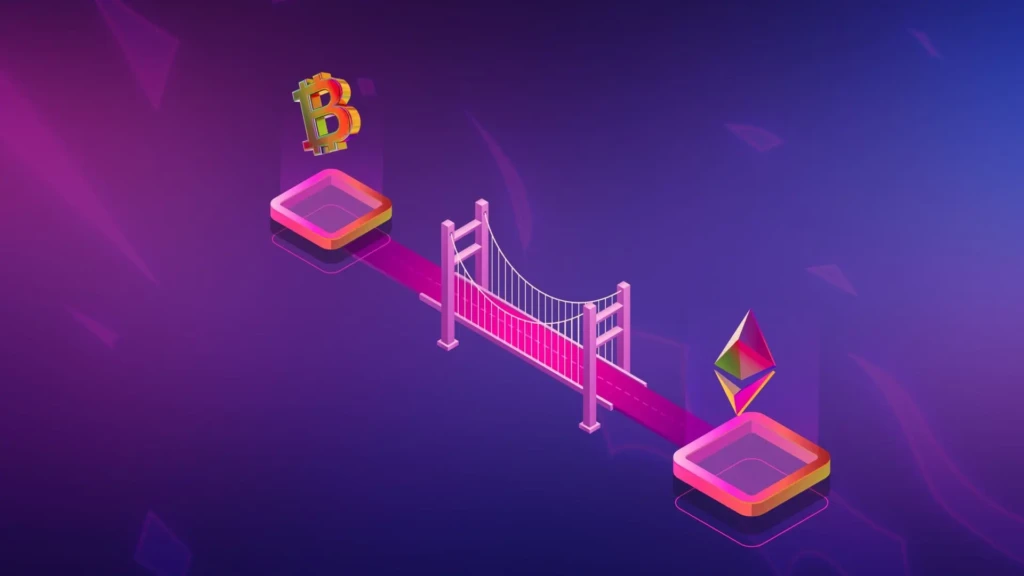How Does a Blockchain Bridge Work?
In the rapidly expanding world of decentralized finance (DeFi), one question stands out for crypto investors and developers alike: how does a blockchain bridge work? These bridges—protocols that connect different blockchains—have become essential to moving assets and data across an increasingly fragmented crypto ecosystem. Understanding their mechanics is critical for anyone navigating today’s multi-chain landscape.
Why Blockchain Bridges Matter
The crypto market is no longer confined to a single dominant chain. Ethereum, Solana, BNB Chain, Avalanche, and countless others all host vibrant ecosystems. Yet these networks remain siloed by design. A token on Ethereum cannot directly move to Solana because each blockchain maintains its own consensus rules and ledger.
Blockchain bridges solve this challenge by creating cross-chain connectivity, enabling users to transfer tokens or data without centralized intermediaries. According to research by Chainalysis and Messari, bridges now facilitate billions of dollars in daily transactions, underscoring their role as critical crypto infrastructure.
Core Mechanics of a Blockchain Bridge
Understanding how does a blockchain bridge work begins with its basic function: locking assets on one chain and minting equivalent assets on another.
Lock-and-Mint Process
- Deposit/Locking: A user sends their token—say ETH—to a smart contract on Chain A.
- Validation: The bridge network verifies the transaction, often through a group of validators or relayers.
- Minting/Wrapping: Once validated, the bridge mints a corresponding wrapped token (e.g., wETH) on Chain B.
This wrapped asset represents the original token and can be redeemed at any time by burning it on Chain B, prompting the release of the locked ETH on Chain A.
Burn-and-Release Mechanism
When the user wants to move back, the reverse occurs. The wrapped token is burned on Chain B, and the original token is unlocked from the smart contract on Chain A. This ensures the total supply across chains remains constant, preventing double spending.
Types of Blockchain Bridges
Not all bridges follow the same architecture. To grasp how does a blockchain bridge work in different contexts, it helps to explore the primary categories.
Trusted Bridges
Trusted bridges rely on a central authority or a group of validators. They are fast and often cheaper but introduce counterparty risk. Examples include early custodial solutions that require users to trust the bridge operator.
Trustless (Decentralized) Bridges
Trustless bridges use smart contracts and decentralized consensus to verify transactions. They are more secure in theory but can be complex and costly. Protocols like Wormhole and LayerZero fall into this category.
Federated Bridges
These operate with a predefined set of validators who sign transactions. While partially decentralized, they still concentrate power among a limited group.
Security Challenges
Despite their utility, blockchain bridges remain high-value targets. Chainalysis reports that bridge hacks accounted for over $2 billion in losses in 2024 alone.
Common vulnerabilities include:
- Smart Contract Exploits: Bugs in bridge code can be exploited to mint fake assets.
- Validator Attacks: If a majority of validators are compromised, attackers can release locked assets without proper burns.
- Replay and Routing Attacks: Exploiting transaction verification weaknesses to double-spend or redirect funds.
Security audits, bug bounties, and multi-signature schemes are becoming standard defenses, but risk remains.
Real-World Examples
Wrapped Bitcoin (WBTC)
One of the earliest and most successful bridges, WBTC allows Bitcoin holders to use their BTC on Ethereum. The system locks Bitcoin with a custodian and mints ERC-20 WBTC tokens for DeFi applications.
Avalanche Bridge
Avalanche’s bridge facilitates fast transfers of Ethereum assets to Avalanche’s high-speed network, demonstrating how bridges can drive liquidity into emerging ecosystems.
Cosmos IBC
The Inter-Blockchain Communication (IBC) protocol offers a native bridging framework within the Cosmos ecosystem, eliminating some of the trust assumptions of older bridges.
Economic and Ecosystem Impact
The ability to move assets across chains fuels:
- DeFi Expansion: Users can access higher yields and new protocols across networks.
- NFT Portability: Creators and collectors can transfer NFTs between blockchains, broadening marketplaces.
- Institutional Adoption: Cross-chain functionality reduces fragmentation, making crypto infrastructure more appealing to enterprises.
However, this interconnectedness can also spread systemic risk. A failure in a major bridge could cascade across multiple chains, amplifying market shocks.
Regulatory Landscape
As bridges grow, regulators are paying attention. Questions arise over:
- Custodial Responsibility: Who is liable when a bridge is hacked?
- KYC/AML Requirements: Should cross-chain transfers be subject to the same scrutiny as centralized exchanges?
The evolving regulatory debate will shape how bridges operate in the coming years.
FAQ: How Does a Blockchain Bridge Work?
Q1: How does a blockchain bridge work for cryptocurrency transfers?
A blockchain bridge locks tokens on one network and mints equivalent tokens on another, enabling cross-chain movement without a centralized exchange.
Q2: How does a blockchain bridge work to maintain token supply integrity?
By burning wrapped tokens before releasing the original assets, bridges ensure the total circulating supply remains constant across chains.
Q3: How does a blockchain bridge work differently for NFTs?
NFT bridges often use similar lock-and-mint processes but include metadata transfer to preserve the NFT’s unique attributes.
Q4: How does a blockchain bridge work compared to centralized exchanges?
Unlike exchanges, bridges do not require users to trust a third party with custody, though they still face smart contract and validator risks.
Conclusion: The Future of Cross-Chain Connectivity
How does a blockchain bridge work today reflects the crypto industry’s push toward a truly interoperable future. As multi-chain ecosystems become the norm, bridges will remain vital infrastructure. Yet their history of exploits and evolving regulatory scrutiny highlight the need for ongoing innovation.
Next-generation solutions—such as zero-knowledge proofs, enhanced validator incentives, and native interoperability layers—could strengthen security and reduce costs. For investors, developers, and policymakers, understanding these protocols is no longer optional. The bridge, quite literally, connects the next era of blockchain technology.

